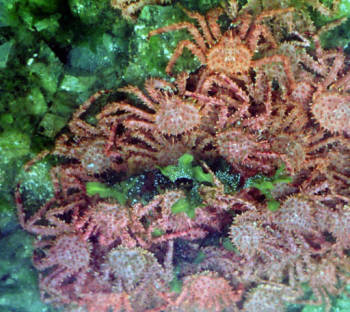King Crab
Category: Crab

Facts about King Crabs, "Scientific name for King Crab is Lithodidae - cold water deep-sea crabs". Due to the King Crabs big size and the flavor of their meat, several species are extensively caught and marketed as food, the most common crab variety being the Red King crab. Generally, the King crab is thought to be resulting from hermit crab-like forerunners, which may enlighten the irregularity still found in the fully developed forms. Even though previously categorized among the hermit crabs, the King crab is now positioned in a separate superfamily class called Lithodoidea.
Features
The King crab has a bigger body, with an armored shell and thick legs. An adult King Crabs can have a maximum leg span, ranging from 21 inches to 5 feet 9 inches (0.6 m to 1.8 m), with a maximum body mass that ranges from 4.4 pounds to 18 pounds (2 kg to 8 kg), according to the variety. The King Crabss are capable of moving at a speed of 11 kilometers per hour (7 miles per hour). Though the King Crabss are acknowledged for their sheer size, only one or two varieties of the King Crabs are really big. They are largely found in the warmer water of the Southern Hemisphere, but some varieties of the King crab are the obvious exemption to this because they use to live in near freezing waters.
The King crab has a strong shell, and they come in different body colors, such as red, orange and blue. Usually, the King crab hunts plankton and small fish in the oceans and they are regularly found near rocky areas or coral reefs where there is copiousness of places for the crab to conceal. The King Crabs main predators include bigger fish, humans and Octopuses. Usually, the King Crabs lead a solitary way of life, and they are considered to be threatened. At present, there are considerations to be approximately 40 dissimilar species of king crab, most of which are pursued for food by humans, owing to their big size body and the flavor of their meat.
Diet
Generally, the King crab feeds on plankton, clams, worms, mussels, brittle stars, snails, sea stars, sea urchins, barnacles, sand dollars, crabs, other crustaceans, algae and sponges and small fish, but they prefer to feed on Molluscs.
Breeding
An adult female King Crab breeds thousands of embryos under her tail flap for about one year. When the embryos are completely grown, the King Crab emerge as swimming larvae, but they are still vulnerable to the movements of currents and tides. Following nourishing on animal and plant plankton for numerous months and undergoing numerous body changes with every molt, the larvae inhabit the bottom of the ocean and molt into non-swimmers, seeking the first time similar to King Crabs. Some varieties of King Crabs live in waters with the depth between 90 feet and 200 feet (27.3 m and 60.6 m), whereas some other varieties can be seen at a minimum depth of 300 feet (90.9 m)
The average lifespan of the King Crabs ranges from 15 years to 30 years, according to their varieties.

 Back To Category Crab
Back To Category Crab